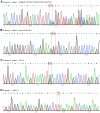Novel dynein axonemal assembly factor 1 mutations identified using whole‑exome sequencing in patients with primary ciliary dyskinesia
- PMID: 33174003
- PMCID: PMC7646867
- DOI: 10.3892/mmr.2020.11562
Novel dynein axonemal assembly factor 1 mutations identified using whole‑exome sequencing in patients with primary ciliary dyskinesia
Abstract
Primary ciliary dyskinesia (PCD) is a rare, genetically heterogeneous disorder caused by dysfunction of the cilia and flagella; however, causative genetic defects have not been detected in all patients with PCD. Seven Chinese Han patients with Kartagener syndrome were enrolled onto the present study. Transmission electron microscopy (TEM) was performed to evaluate the cilial defects and whole‑exome sequencing was used to analyze relevant genetic variations in all patients. In two of the seven patients with PCD, four novel dynein axonemal assembly factor 1 (DNAAF1) mutations were identified (NM_178452.6:c.3G>A, c.124+1G>C, c.509delG and c.943A>T) in three alleles. Both of these patients had long‑standing infertility. Their chest computed tomography results showed bronchiectasis, lung infections and situs inversus, and paranasal computed tomography revealed sinusitis. Semen analysis of the male patient showed poor sperm motility. TEM showed defects in the inner and outer dynein arms in both patients. The DNAAF1 sequences of family members were then analyzed. Bioinformatics analysis indicated that these mutations may be the cause of the cilial defects in these two probands. Thus, the present study identified novel PCD‑causing mutations in DNAAF1 in two patients with PCD. These genetic variations were predicted to alter DNAAF1 amino acid residues and lead to loss of function, thereby inhibiting cilia‑mediated motility. Accordingly, the two probands had PCD symptoms, and one of them died due to PCD‑associated complications.
Figures






Similar articles
-
Mutations of DNAH11 in patients with primary ciliary dyskinesia with normal ciliary ultrastructure.Thorax. 2012 May;67(5):433-41. doi: 10.1136/thoraxjnl-2011-200301. Epub 2011 Dec 18. Thorax. 2012. PMID: 22184204 Free PMC article.
-
Mutations in SPAG1 cause primary ciliary dyskinesia associated with defective outer and inner dynein arms.Am J Hum Genet. 2013 Oct 3;93(4):711-20. doi: 10.1016/j.ajhg.2013.07.025. Epub 2013 Sep 19. Am J Hum Genet. 2013. PMID: 24055112 Free PMC article.
-
Dynein axonemal heavy chain 10 deficiency causes primary ciliary dyskinesia in humans and mice.Front Med. 2023 Oct;17(5):957-971. doi: 10.1007/s11684-023-0988-8. Epub 2023 Jun 13. Front Med. 2023. PMID: 37314648
-
Ciliary defects and genetics of primary ciliary dyskinesia.Paediatr Respir Rev. 2009 Jun;10(2):51-4. doi: 10.1016/j.prrv.2009.02.001. Epub 2009 Apr 18. Paediatr Respir Rev. 2009. PMID: 19410201 Review.
-
CCDC40 mutation as a cause of primary ciliary dyskinesia: a case report and review of literature.Clin Respir J. 2016 Sep;10(5):614-21. doi: 10.1111/crj.12268. Epub 2015 Mar 3. Clin Respir J. 2016. PMID: 25619595 Review.
Cited by
-
Clinical and genetic spectrum of primary ciliary dyskinesia in Chinese patients: a systematic review.Orphanet J Rare Dis. 2022 Jul 19;17(1):283. doi: 10.1186/s13023-022-02427-1. Orphanet J Rare Dis. 2022. PMID: 35854386 Free PMC article.
-
The impact of primary ciliary dyskinesia on female and male fertility: a narrative review.Hum Reprod Update. 2023 May 2;29(3):347-367. doi: 10.1093/humupd/dmad003. Hum Reprod Update. 2023. PMID: 36721921 Free PMC article. Review.
-
Primary Ciliary Dyskinesia Caused by Homozygous DNAAF1 Mutations Resulting from a Consanguineous Marriage: A Case Report from Japan.Intern Med. 2024 Oct 15;63(20):2847-2851. doi: 10.2169/internalmedicine.3263-23. Epub 2024 Mar 4. Intern Med. 2024. PMID: 38432987 Free PMC article.
-
A novel homozygous mutation in the DNAAF3 gene leads to severe asthenozoospermia and teratospermia.J Cell Mol Med. 2024 Sep;28(18):e70092. doi: 10.1111/jcmm.70092. J Cell Mol Med. 2024. PMID: 39289782 Free PMC article.
References
-
- Frommer A, Hjeij R, Loges NT, Edelbusch C, Jahnke C, Raidt J, Werner C, Wallmeier J, Große-Onnebrink J, Olbrich H, et al. Immunofluorescence analysis and diagnosis of primary ciliary dyskinesia with radial spoke defects. Am J Respir Cell Mol Biol. 2015;53:563–573. doi: 10.1165/rcmb.2014-0483OC. - DOI - PMC - PubMed
MeSH terms
Substances
LinkOut - more resources
Full Text Sources
Molecular Biology Databases

